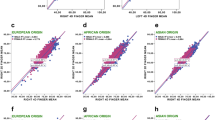Summary
Finger ridge-counts of 109 45,X Turner's syndrome patients were compared to normal controls by means of discriminant functions. Each subject was represented by 20 variables, a radial and an ulnar count for each digit. Not only do Turner patients exhibit larger counts, but the distribution of counts over the digits is altered considerably. The Turnernormal differences appear to correspond to previously defined developmental fields.
Similar content being viewed by others
References
Barlow P (1973) The influence of inactive chromosomes on human development. Hum Genet 17:105–136
Ciovirnache M, Stanescu V, Ionescu V, Floren I, Grigorescu A (1968) Les dermatoglyphes dans le syndrome de Turner. Rev Roum Endocrinol 5:287–301
Corballis MC, Morgan MJ (1978) On the biological basis of human laterality: I. Evidence for maturational left-right gradient. Behav Brain Sci 2:261–269
Dixon WJ (1976) Biomedical computer programs. University of California Press, Los Angeles
Farman N, Borgaonkar DS, Zaczek B (1979) Dermatoglyphic studies in Turner syndrome. In: Dermatoglyphics-50 years later. Birth Defects 15:609–620
Forbes AP (1964) Fingerprints and palm prints (dermatoglyphics) and palmar flexion creases in gonadal dysgenesis, pseudohypoparathyroidism and Klinefelter's syndrome. N Engl J Med 270:1268–1277
Holt SB (1968) The genetics of dermal ridges. Charles C. Thomas, Springfield
Holt SB, Lindsten J (1964) Dermatoglyphic anomalies in Turner's syndrome. Ann Hum Genet 28:87–100
Jantz RL, Owsley DW (1977) Factor analysis of finger ridge-counts in Blacks and Whites. Ann Hum Biol 4:357–366
Mittwoch U (1976) Lateral asymmetry and the function of the mammalian Y chromosome. In: Jones K, Brandham P (eds) Current chromosome research. North-Holland Biomedical Press, Amsterdam, p 195
Penrose LS (1967) Fingerprint pattern and the sex chromosomes. Lancet 1:298–300
Penrose LS, Loesch D (1967) A study of dermal ridge width in the second (palmar) interdigital area with special reference to aneuploid states. J Ment Defic Res 11:36–42
Pfeiffer RA, Kiera W (1968) Dermatoglyphen bei Turner-Syndrom. Acta Genet Med Gemellol (Rome) 27:507–522
Reed T, Reichmann A, Palmar CG (1977) Dermatoglyphic differences between 45,X and other chromosomal abnormalities of Turner syndrome. Hum Genet 36:13–23
Reed T, Norton JA, Christian JC (1978) Components of variation in a multifactorial character: a dermatoglyphic analysis. Hum Biol 47:169–188
Siervogel RM, Roche AF, Roche EM (1978) Developmental fields for digital dermatoglyphic traits as revealed by multivariate analysis. Hum Biol 50:541–556
Author information
Authors and Affiliations
Rights and permissions
About this article
Cite this article
Jantz, R.L., Ranyard, G.C. & Owsley, D.W. Finger ridge-count variation in 45,X Turner's syndrome. Hum Genet 57, 376–379 (1981). https://doi.org/10.1007/BF00281688
Received:
Revised:
Issue Date:
DOI: https://doi.org/10.1007/BF00281688




